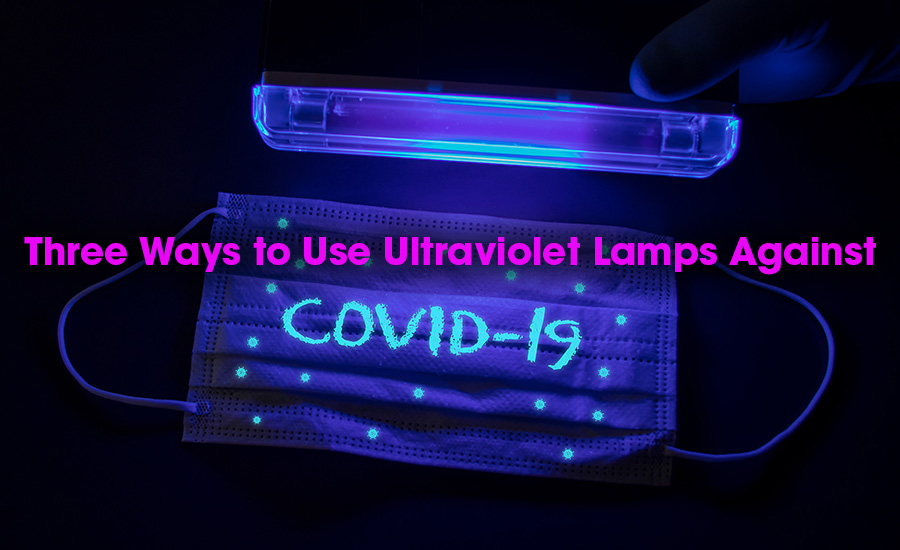The economic and social disruption due to COVID-19, the disease caused by a coronavirus called SARS-CoV-2, has devastated countless people around the world. This ongoing global pandemic has not only changed the way we operate on a daily basis, but it has changed our views of many different aspects of life. One can only hope that these changes in perceptions have led people to a clearer understanding of what is most important and valuable in their lives. However, no matter where this road has taken someone, there is one common, overriding concern - how do we fight this problem?
There are many options available to help prevent the spread of the virus. Some of these options are: filtration systems, disinfectants, electrostatic sprayers, hand sanitizers, etc. One option that has become extremely popular is the use of ultraviolet-C (UVC) lamps – wavelengths ranging from 100 – 280 nm. The demand for UVC lamps has skyrocketed as people have become more educated on what they do and how they apply to the COVID-19 outbreak. Why is this?
According to the FDA, UVC radiation is a known disinfectant for air, water, and nonporous surfaces. It has been used effectively for decades to reduce the spread of bacteria, like tuberculosis. For this reason, UVC lamps are often called “germicidal” lamps. UVC radiation has also been shown to destroy the outer protein coatings of certain viruses, which ultimately leads to inactivation of the virus. When people begin to understand how UVC lamps work, they often start researching how they can be added to existing protocols.
In the cleaning and restoration industry, there are three main ways that UVC lamps can be applied. The first is treating the aerosolized viruses. This requires the air in an environment to pass through the UVC lamp chamber to ensure direct exposure to the radiation. When setting up air purifiers containing the UVC lamps, contractors should focus on getting all of the air circulating through the chamber containing the lamps. Proper placement of the machines, and using additional air movers, can help achieve this. Depending on the size and layout of the structure, it is likely that multiple air purifiers will be needed to guarantee a complete treatment.
The second way UVC lamps can be used in the cleaning and restoration industry is to use wands, or other similar mechanisms, to treat hard surfaces. It is critical to do some research and understand the brand’s UVC wavelengths, dose, recommended distance from treatment area, and duration of radiation exposure to ensure effectiveness. It is generally recognized that UVC cannot inactivate a virus or bacterium if it is not directly exposed to UVC – such as an area which is covered by dust, embedded in porous surface, or on the underside of a surface. Once you learn how to use these devices, they can be good tools to add to an arsenal for treating items and surfaces that you would prefer not to spray with chemicals. Moving them over certain areas, obviously following the guidelines for both distance and dwell time, can be a great way to improve the success on these projects.
While these devices can be very effective, they also come with some risks. The biggest concern is exposing eyes or skin to the invisible UVC light at close range, as it can cause damage. Even more concerning is the harm is not instantaneous – meaning it may take several days before you realize you have impaired your eyes or caused burn-like skin reactions. Individuals who use these tools should be trained and strictly follow the guidelines specific to that particular UVC wand. Furthermore, the devices should always be monitored, and not left behind, to make certain no one else has access to them. Lastly, contractors should be aware what materials (e.g., plastic, polymers, dyed textiles) might be degraded if improperly exposed to UVC.
The third way UVC lamps can be used is with machines that incorporate more than one UVC wavelength into their technology to produce oxidants – specifically ones that are capable of deactivating pathogens. This type of technology produces hydroxyl, oxy, and peroxy radicals that exit the chamber of the machine, and then circulate through the room to react with pathogens both in the air and on hard surfaces.
Like the other UVC options, it is important to understand how to deploy these machines on a project. The most important factors to consider are what the coverage area is and how long they should run to be effective. A key point to remember is that the air coming out of these machines is where you will find the radicals. The simplest strategy is to get that air distributed throughout the room so that it touches not only the key touch points, but also the harder to reach areas such as behind furniture, the top of bookshelves, ceiling tiles, etc.
Another option to consider with machines that use this UVC technology is to leave them behind with the customer. They may be run 24/7 and provide added treatment, even after the initial physical work is done. The reason this can be valuable is it addresses the concern regarding people who enter and exit a building between cleanings. While these machines won’t fully prevent the spread of the coronavirus, they can at least add a layer of protection to help minimize it.
Implementing a multi-pronged approach in combating the coronavirus is a strategy that many companies have embraced. UVC lamps are not intended to replace what is already being used, such as spraying and wiping, using filters, etc. However, adding the UVC lamps to one’s existing protocol will increase the overall effectiveness on projects, and ultimately put the clients more at ease. If this type of work is an area of interest, it is best to do your research, ask questions, get trained, and properly implement the various tools to ensure success; your clients are depending on you.

